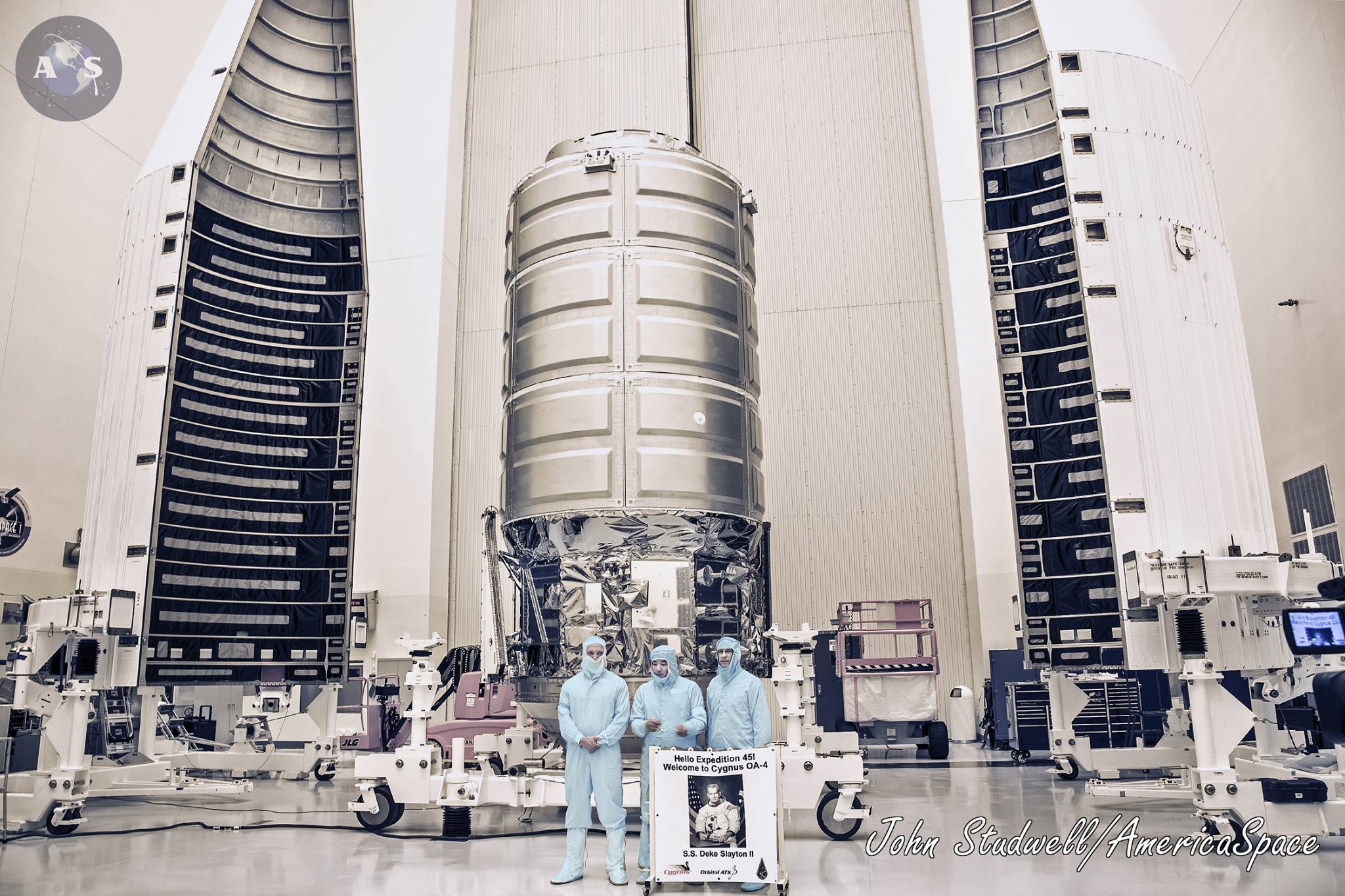
More than a year since the catastrophic loss of its ORB-3 mission—which fell back onto Pad 0A at the Mid-Atlantic Regional Spaceport (MARS) on Wallops Island, Va., following the failure and explosion of its Antares booster, seconds after liftoff—Orbital ATK is primed to return its Cygnus cargo spacecraft to flight on Thursday, 3 December. The mission will launch atop a United Launch Alliance (ULA) Atlas V 401 booster from Space Launch Complex (SLC)-41 at Cape Canaveral Air Force Station, Fla., during a 30-minute “window” which opens at 5:55 p.m. EST.
Bound for the International Space Station (ISS) and its incumbent Expedition 45 crew of Commander Scott Kelly of NASA, Russian cosmonauts Mikhail Kornienko, Oleg Kononenko, and Sergei Volkov, U.S. astronaut Kjell Lindgren, and Japan’s Kimiya Yui, the OA-4 mission will differ from its predecessors by marking the first outing of an “Enhanced” Cygnus, equipped with a “stretched” Pressurized Cargo Module (PCM), which houses more than 7,000 pounds (3,100 kg) of equipment and consumables for the station’s crew. In keeping with tradition, and offering a touching homage to the failed ORB-3, tomorrow’s flight will revive the name “Spaceship Deke Slayton,” in honor of one of America’s “Original Seven” Mercury astronauts.
Bookmark our Mission Tracker for regular countdown updates and LIVE COVERAGE on launch day!
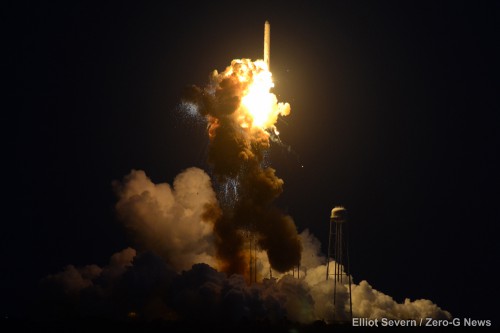
Under the language of its December 2008 Commercial Orbital Transportation Services (COTS) agreement with NASA, the Dulles, Va.-based Orbital Sciences Corp. was required to deliver 44,000 pounds (20,000 kg) of payloads to the ISS during eight dedicated Cygnus flights, under a $1.9 billion contract, originally targeted to be accomplished by 2016. However, lengthy delays in the preparation of its liquid-fueled Antares booster and associated cryogenic tankage at the MARS site delayed the inaugural flight (“A-ONE”) by over a year, until the rocket eventually undertook its maiden voyage in April 2013. This was followed by an initial “demonstration” mission (ORB-D) of Cygnus to the ISS in September 2013, which cleared the final milestones and allowed Orbital to press ahead with its eight dedicated cargo delivery runs. Two successful flights in January and July 2014 (ORB-1 and ORB-2) were executed, prior to last October’s failure of ORB-3. The accident was ultimately blamed upon a liquid oxygen turbopump failure and subsequent explosion in one of Antares’ twin Aerojet Rocketdyne-furnished AJ-26 first-stage engines.
In the aftermath of the accident, Antares was grounded as Orbital—which merged with the Arlington, Va.-based Alliant Techsystems, Inc. (ATK) in February 2015—sought to replace the Russian-heritage AJ-26 with the upgraded RD-181 first-stage powerplant, tracking a maiden flight of the enhanced “Antares 230” vehicle by mid-2016. Concurrently, the company contracted with United Launch Alliance (ULA) to fly at least two Cygnuses aboard the highly reliable Atlas V, out of Cape Canaveral Air Force Station, Fla., with OA-4 targeted for the fall of 2015 and OA-6 for the spring of 2016. This would then allow for a resumption of Antares-launched Cygnus flights with OA-5, no sooner than May 2016. The “OA” designator recognizes the recent merger of the two companies.
As outlined in a previous AmericaSpace article, OA-4 will demonstrate the new Enhanced Cygnus, whose cylindrical PCM—based upon the Italian-built Multi-Purpose Logistics Module (MPLM), which flew on 12 occasions aboard the shuttle between March 2001 and July 2011—can deliver an approximately 53 percent larger haul of payloads and supplies than its predecessor. The spacecraft also boasts lightweight UltraFlex solar arrays. In fact, OA-4 will carry 7,383 pounds (3,349 kg) of total cargo, about 40 percent greater than earlier Cygnuses, to support ongoing scientific research, maintenance, crew needs, and upcoming EVAs. It will also reflect one of the heaviest missions ever launched by a member of ULA’s Atlas V fleet, whose current heavyweight record-holder is believed to be the members of the Mobile User Objective System (MUOS) series of satellites, each of which tips the scales at more than 15,000 pounds (6,800 kg). In order to accommodate the Enhanced Cygnus—whose PCM and unpressurized Service Module (SM) stands 21 feet (6.3 meters) tall, some 4 feet (1.2 meters) longer than its predecessors—the Atlas V is equipped with a 45.3-foot-tall (13.8-meter) Extra-Extended Payload Fairing (XEPF). This will top-off the booster at an impressive 194 feet (59.1 meters).
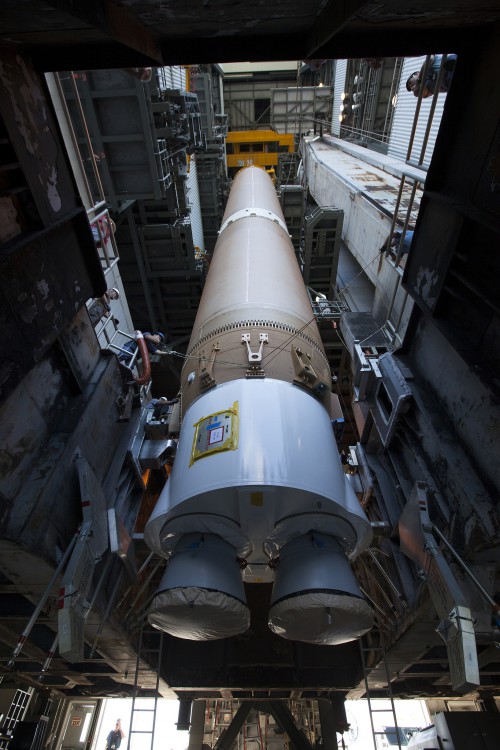
First flown back in August 2002, the Atlas V will be flying for the 60th time tomorrow and carries a reputation as one of the most reliable rockets in active operational service, with a near-perfect success record. For OA-4, it will also be flying for the 30th time in its “barebones” 401 configuration, equipped with a 14-foot-diameter (4-meter) payload fairing, no strap-on boosters, and a single-engine Centaur upper stage, which carries the capability to transport up to 21,600 pounds (9,800 kg) into low-Earth orbit and up to 10,470 pounds (4,750 kg) into Geostationary Transfer Orbit (GTO). Key missions by the 401 have included a pair of commercial communications satellites—notably the Atlas V’s very first passenger, Hot Bird-6—as well as 18 military research, communications, reconnaissance, early-warning, weather-monitoring, and navigation payloads, the Red Planet-bound Mars Reconnaissance Orbiter (MRO) and Mars Atmosphere and Volatile Evolution (MAVEN) spacecraft, the Lunar Reconnaissance Orbiter (LRO) and Lunar Crater Observation and Sensing Satellite (LCROSS), the Van Allen Probes, the Solar Dynamics Observatory (SDO), Landsat-8 and WorldView-3, and the latest members of NASA’s Tracking and Data Relay Satellite System (TDRSS). Earlier in 2015, ULA celebrated a cumulative 100 missions since its formation in December 2006, of which more than a quarter have been accomplished through the use of the Atlas V 401.
Following the shipping of the OA-4 Cygnus SM to the Kennedy Space Center (KSC) in Florida in October 2015, it was immediately transferred to the Space Station Processing Facility (SSPF) for checkout and integration with the PCM, which had arrived in early August. During this period, technicians completed the packing of many of its experiments and supplies. The complete Cygnus was then moved into the Payload Hazardous Servicing Facility (PHSF)—becoming the first ISS-bound spacecraft to occupy this facility—for loading with hydrazine and oxidizer propellants. In the aftermath of a media event at the PHSF on 13 November, the Cygnus was encapsulated within the two halves of the “bisector” XEPF. Meanwhile, the 41.5-foot-long (12.6-meter) Centaur upper stage arrived at the Horizontal Integration Facility (HIF) at nearby Cape Canaveral Air Force Station in late October and by mid-November had been joined by the Atlas V 401’s 106.5-foot-long (32.5-meter) first stage.
As detailed in a recent Photo Feature by AmericaSpace Managing Editor Mike Killian, the Cygnus was hoisted atop the Atlas V/Centaur stack at SLC-41’s Vertical Integration Facility (VIF) on 20 November. Yesterday (Tuesday, 1 December), the standard Launch Readiness Review (LRR) was concluded, producing a definitive “Go” for the opening launch attempt. The anticipated 35-minute rollout of the Atlas V 401 from the VIF to the nearby SLC-41 pad surface—a distance of about a quarter-mile (400 meters)—was scheduled to take place on Wednesday, ahead of Thursday’s opening launch attempt. Upon arrival on the pad, the booster will be carefully centered and propellant umbilicals and electrical and data connections will be established. The track mobiles from the Mobile Launch Platform (MLP) will be removed and ULA engineers will prepare for formal countdown operations.
Unlike many previous ISS-bound cargo missions, which typically require “launch windows” ranging from “instantaneous” to no more than 5-10 minutes, this mission will benefit from a far more spacious, 30-minute opportunity. According to Jim Sponnick, ULA’s vice president for Atlas and Delta programs, instantaneous windows are the standard way to accomplish a rendezvous mission with a low-Earth object like the ISS, but “this approach can significantly limit the probability of an on-time launch.” He noted that ULA “always strives to implement longer launch windows in our mission designs to maximize the probability of a first-day launch for our customers.” In comments provided to AmericaSpace by ULA’s Lyn Chassange, Mr. Sponnick added that “We have been enhancing our mission design capabilities and operational processes for years in order to make good use of the launch vehicle performance to provide the flexibility to accomplish launch window objectives.”
The ULA and Orbital ATK teams worked closely to produce a mission design which would provide for the longer window, thereby accounting for short-notice changes in the space station’s orbit, such as the need to perform a Debris Avoidance Maneuver (DAM). “The OA-4 launch design approach accounts for the fact that the ISS orbit can change shortly before the launch, if either an overall orbit adjustment or evasive debris mitigation maneuver is required,” explained Mr. Sponnick in quotes provided to AmericaSpace. “Considering the capabilities inherent in the Atlas design, the late changes that can occur in the ISS orbit and the close co-ordination with the Orbital ATK Cygnus rendezvous design, we have implemented a 30-minute-long window, which will occur within a bounding 50-minute-long window that accounts for the potential late orbital changes for the ISS.” Added ULA CEO Tory Bruno in a recent tweet: “Mighty Atlas’ unique ability to get this dbl load to ISS on L-Day #1: Sophisticated RAAN Steering & raw power.”
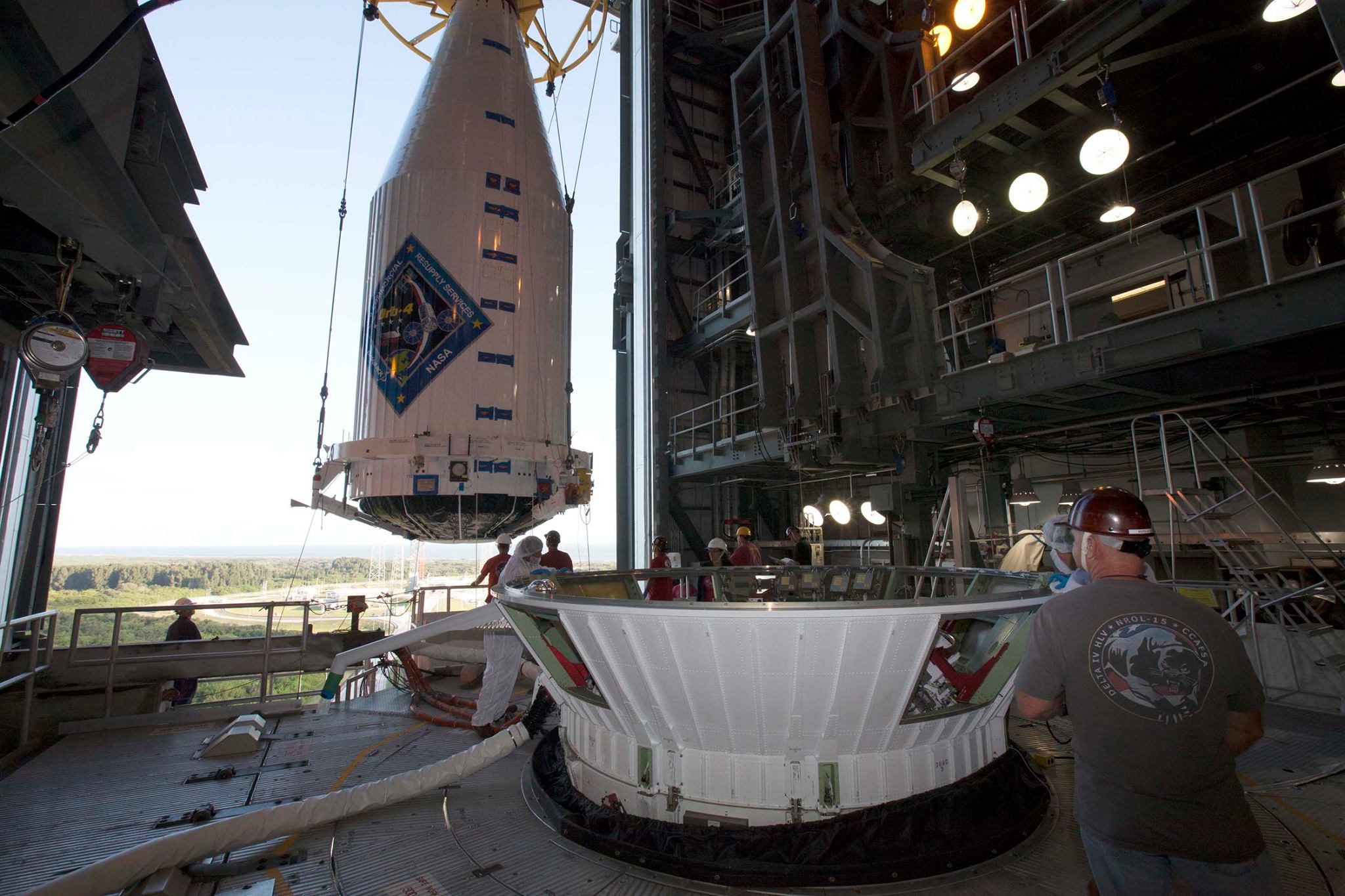
Current predictions from the 45th Weather Squadron at Patrick Air Force Base anticipate a 60-percent probability of acceptable conditions for a launch tomorrow. The launch window opens at 5:55 p.m. EST, about 30 minutes after local sunset, which will undoubtedly generate a spectacular light show for observers along the Space Coast. According to NASA, principal meteorological concerns center upon cumulus clouds, disturbed weather and thick clouds and the 45th Weather Squadron has provided an extensive analysis, detailing “favorable weather … with an isolated shower threat” during today’s rollout to the pad, tempered by an increased risk of rain and thunderstorms tonight. “On launch day, the cold front becomes stationary in South Florida with high moisture and cloudy conditions persisting over Central Florida,” it was explained. “The primary concerns for launch are cumulus clouds, disturbed weather and thick clouds.” In the event of a 24-hour postponement of the launch to Friday evening, it was added that “low pressure develops along the boundary in the Atlantic Friday morning, with cloudy conditions and isolated showers persisting through the day.” Coupled with the presence of ground winds, this is expected to produce a 40-percent overall likelihood of acceptable conditions at T-0.
Following a final “Go/No-Go” poll of all stations, the Terminal Countdown will commence in the final minutes and the clock will be released from its last “hold point” at T-4 minutes at 5:51 p.m. EST Thursday. All propellant tanks will be pressurized and the Flight Termination System (FTS)—tasked with destroying the vehicle in the event of a major accident during ascent—will be placed onto internal power and armed. The Atlas V 401’s Russian-built RD-180 engine, with a propulsive yield of 860,000 pounds (390,000 kg), will ignite about 2.7 seconds before lifting, burning a mixture of liquid oxygen and a highly refined form of rocket-grade kerosene, known as “RP-1.” Climb-out of the stack from SLC-41 will get underway at T+1.1 seconds.
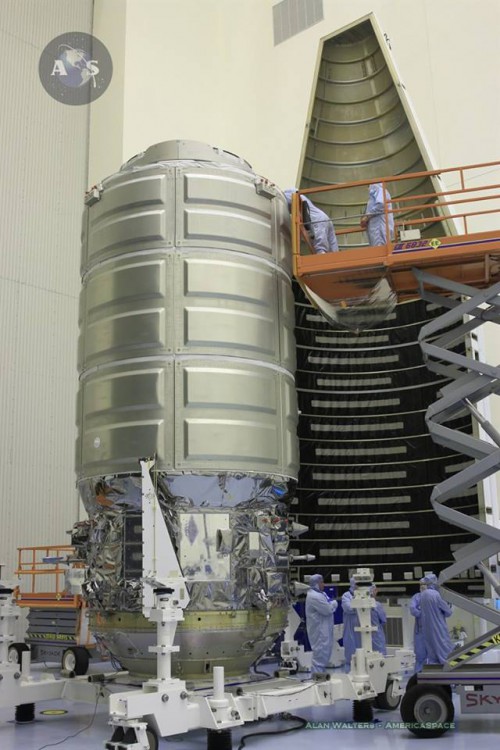
According to ULA’s media booklet for the mission, the initial vertical ascent away from the pad will be succeeded by a Centaur-commanded pitch, roll, and yaw program maneuver, to establish the vehicle onto its proper flight azimuth of 44.4 degrees. Burnout of the Atlas is anticipated about four minutes into the flight, after which the Centaur’s RL-10C engine—fueled with liquid oxygen and hydrogen and capable of 22,900 pounds (10,390 kg) of thrust—will conduct a single “burn,” lasting about 14 minutes. During this period, the two halves of the XEPF bisector will be jettisoned, exposing the OA-4 Cygnus to the space environment for the first time. This will create the proper conditions for insertion into an initial orbit of 124 nautical miles (229.6 km), inclined 51.6 degrees to the equator, and the ISS-bound spacecraft is targeted to separate from the Centaur a little over 21 minutes after departing Cape Canaveral.
This will position the OA-4 Cygnus on course for a rendezvous and capture by the space station’s 57.7-foot-long (17.6-meter) Canadarm2 robotic arm at about 6:05 a.m. EST on Sunday, 6 December. For the first time in history, an unpiloted Visiting Vehicle (VV) will be berthed at the Earth-facing (or “nadir”) Common Berthing Mechanism (CBM) of the station’s Unity node. Although the node was one of the earliest ISS components to reach orbit—launched aboard STS-88 in December 1998—it has been occupied at various points during its 17 years aloft. It provided an early home for Pressurized Mating Adapter (PMA)-3, enabling the shuttle dockings of STS-97 and STS-98 in the winter of 2000-2001, and routinely supported Italian-built MPLMs during several flights prior to and after the Columbia disaster, before being occupied by the Leonardo Permanent Multipurpose Module (PMM) in February 2011. This “permanence” ended in May 2015, when the Leonardo PMM was robotically relocated to a new home on the station’s Tranquility node, allowing the Unity nadir interface to once again become available for visiting cargo craft.
As a result, the ISS now has two berthing locations—one at Unity nadir, the other at the nadir port of the Harmony node—for unpiloted Cygnuses from Orbital ATK, Dragons from SpaceX and H-II Transfer Vehicles (HTVs) from the Japan Aerospace Exploration Agency (JAXA). This will allow for the simultaneous presence of two VVs and, with SpaceX expected to launch its Commercial Resupply Services (CRS)-8 Dragon mission towards the ISS in early January 2016, the New Year should see both of NASA’s COTS partners on-station at the same time, for the very first time.
Leading the rendezvous, capture and berthing of the OA-4 Cygnus on Sunday will be Expedition 45 astronaut Kjell Lindgren, backed-up by Commander Scott Kelly. Both men will be stationed in the multi-windowed cupola. Assisting them will be Japan’s Kimiya Yui, who will be monitoring OA-4 telemetry on the Hardware Control Panel (HCP) and all three U.S. Orbital Segment (USOS) astronauts will support the post-berthing outfitting of the Unity nadir CBM interface, prior to hatch opening and ingress into the spacecraft. Current plans envisage Lindgren grappling Cygnus at 5:30 a.m. EST and the cargo craft should be firmly berthed at Unity nadir by about 7:15 a.m. Unlike earlier Cygnuses—which remained on-station for between 23 and 37 days—the OA-4 vehicle is expected to remain berthed until 25 January 2016, totaling around 50 days. “The seven weeks Cygnus will spend at the station is to accommodate payload unloading and trash loading,” NASA’s Rob Navias recently told AmericaSpace, “coupled with other vehicle traffic during that timeframe.”
That vehicle traffic is expected to be significant and has already led to an ISS Program-level decision to move the return date of the Soyuz TMA-17M crew—Oleg Kononenko, Kjell Lindgren, and Kimiya Yui—forward by almost two weeks from 22 December to 11 December. Their early landing thus removes the opportunity for a second “direct handover” of ISS crew members in 2015. With Soyuz TMA-19M and its crew of Yuri Malenchenko, Tim Kopra, and Tim Peake expected to arrive at the station on 15/16 December, followed by the departure of Russia’s Progress M-28M and the arrival of the new Progress-MS cargo ships, just before Christmas, not to mention SpaceX’s CRS-8 Dragon in early January, the coming weeks are stacking up to be a busy time for the station.
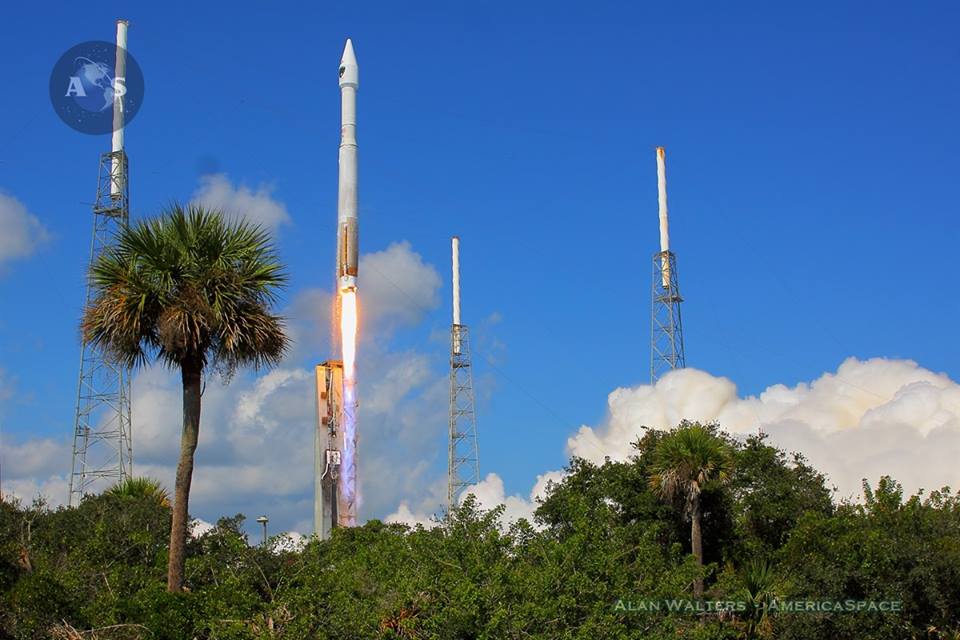
Each Cygnus mission has been named in honor of an individual who has contributed to the goals of Orbital Sciences Corp. or, more broadly, to the commercial space exploration agenda. ORB-D in September 2013 paid tribute to veteran astronaut and senior Orbital executive G. David Low—a key player in the COTS program, before his untimely passing in February 2008—whilst ORB-1 bore the name of former shuttle commander C. Gordon Fullerton and ORB-2 honored five-time space flyer Janice Voss. Continuing the tradition, the ill-fated ORB-3 paid homage to Project Mercury astronaut Deke Slayton and it was recently revealed that his name would be revived for OA-4, which will become known as “Spaceship Deke Slayton II.”
“With the naming of this spacecraft, we continue our commitment to honor to late Donald ‘Deke’ Slayton, one of the original Mercury Seven astronauts and a champion of America’s commercial space program and leadership in space,” said shuttle and ISS veteran Frank Culbertson, who presently heads Orbital ATK’s Space Systems Group. “We are pleased that the Enhanced Cygnus that bears his name will be able to provide up to 53 percent more in cargo weight to the International Space Station than our previously-flown Standard version.” Yet there is more significance to the story than a name. Like his mechanized namesake, Slayton was unsuccessful in his first bid to reach space—grounded by a heart murmur in early 1962, just weeks before he was due to fly the Mercury-Atlas-7 (“Delta 7”) mission—before eventually gaining his astronaut’s wings in July 1975, during the Apollo-Soyuz Test Project (ASTP). And to add another twist: Slayton’s Mercury mission, so cruelly snatched from him, would have launched atop an Atlas … an ancestor of the booster which will propel Spaceship Deke Slayton II into orbit tomorrow.
Be sure to “Like” AmericaSpace on Facebook and follow us on Twitter: @AmericaSpace
.
Missions » ISS » COTS » CYGNUS » ORB-4 »



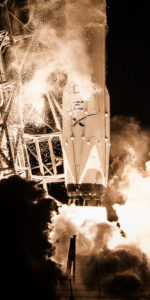
Best wishes to OA and ULA for a successful mission.
I hope the weather holds. Twilight launches are always the most spectacular.
Taxpayers can count the billions wasted on commercial cargo and corporate welfare for NewSpace. ULA had to be brought in to get the job done.
ULA dropped it’s price for the basic 401 Atlas V down to $100 million which made it affordable for OATK to use. If ULA would’ve offered this price 8 years ago, they would’ve owned 1/2 of the U.S cargo launches to the ISS. Competition is good.
Anyway, good luck to OATK & ULA.
“Competition is good” has long been worn-out as the NewSpace solution-to-all-problems slogan.
The balancing of cooperation and competition with the center post of regulation between the arms of the scale is what results in the best possible outcome. Unfortunately in the real world most often cooperation devolves into conspiracies that game the system and competition becomes a race to the bottom of the junk pile. Without strict controls which both the gamers and greedy fight tooth and nail to prevent or remove the process becomes incredibly wasteful.
In the case of spaceflight technology the NewSpace vision of “competition” is a dead end. The cheap exploding hobby rocket that will fly 40 times and create miracle fuel depots and open the solar system to entrepreneurship- the worst thing that has ever happened to space exploration. There is no cheap.
Can’t depend on 100% government effort. The last 40 years have shown that. Too many program cancellations. Private investment in their own ideas is what was missing. Now that piece of the puzzle has been found. Any rocket that is developed without government money could be considered cheap and likely to explode by your definition. If billionaires and millionaires want to spend their money developing “hobby rockets,” more power to them. What you or I think is of no consequence to these “hobby rocket billionaires(Musk, Bezos, Allen and the rest).” But they do offer jobs for ex-NASA engineers.
Thanks for every other informative website.
Where else could I get that type of info written in such an ideal manner?
I have a venture that I’m simply now operating on, and
I have been on the glance out for such information.